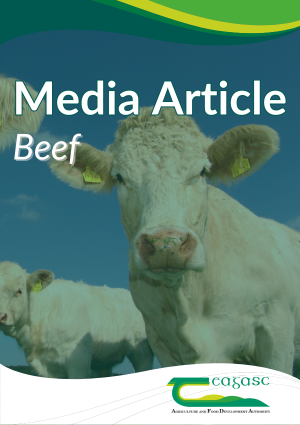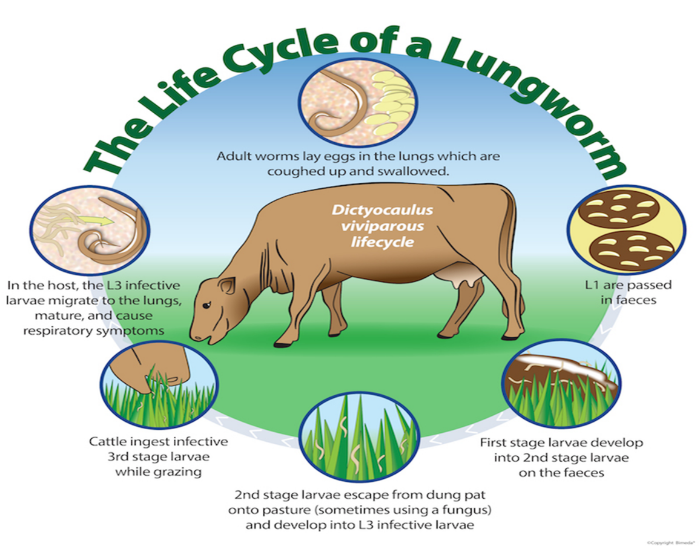
Parasite Control at Housing
Parasite Control at Housing 18 December 2024 Type Media Article By Cathal Gormley, B&T Drystock Advisor, Teagasc Galway/Clare With the Mild Autumn, many cattle remained out later grazing then other years. Now that all cattle are housed on most farms, it is an ideal time to treat animals for parasites. The main parasites on farms […]
By By Cathal Gormley, B&T Drystock Advisor, Teagasc Galway/Clare

Parasite Control at Housing
Type Media Article
By Cathal Gormley, B&T Drystock Advisor, Teagasc Galway/Clare
With the Mild Autumn, many cattle remained out later grazing then other years. Now that all cattle are housed on most farms, it is an ideal time to treat animals for parasites.
The main parasites on farms that need to be addressed are:
- Lungworm
- Stomach worms- Gut worms
- Liver fluke
- Rumen Fluke
- External Parasites
Why is housing the ideal time to control Parasites? The main reason is the animals are no longer grazing and are not exposed to them. The housing period is a break in the cycle of many of these parasites. Having a good winter plan in place is important, have regular discussions with your Vet about what needs to be treated and put a plan in place. It could be a case traditionally you treating for parasites that are not present on farm, or the opposite not treating for what you should be. Consider taking a faecal sample to identify what needs to be treated. Faeces sample are used for detection of worms and fluke eggs in all cattle.
Many farms traditionally complete the bulk of treatments around the Christmas period, as it is a good time to hit parasites at the correct stages as well as having increased help around the Christmas. The most important factor when treating is to know what each product treats for. Many of these parasites have a big negative effect on animal performance if not treated correctly.
Internal Parasites
Dosing strategies should provide sufficient cover from both lungworm and stomach worm. The development of anthelmintic resistance in stomach worm populations also needs to be considered. What is Resistance? It is where wormers used will not treat the parasite correctly and worms will remain after treatment is administered. Ensure animals are dosed correctly with regards advice for each product.

Fluke is another important Parasite to treat. Liver fluke has an external host- Mud Snail. Liver fluke will occur on most farms. Using the farm’s history when treating is important, understanding the parasite is important when treating as it has 3 stages and different products treat different stages.
- Early immature (first 5-6 weeks),
- Immature fluke (6-10/11 weeks)
- Adult fluke (11+ weeks)
Research the products before purchase check out AHI have good information on their October Bulletin on fluke. Liver fluke reports from the Beef Health Check Programme are available online for beef and dairy animals sent to slaughter at participating factories through the ICBF website
Product list for the control of fluke
|
Active Ingredient |
Sample product |
Dose after cattle housed |
|
Admin route |
Withdrawal |
|---|---|---|---|---|---|
|
Triclabendazole |
Endofluke 10% |
2 weeks |
Early |
Oral drench |
56 days |
|
|
Fasinex 240 |
2 weeks |
Immature |
Oral drench |
56 days |
|
|
Tribex 10% |
|
Immature, adult fluke |
Oral drench |
56 days |
|
|
Cydecdectin Triclamox |
6 weeks |
|
Pour on |
143 days |
|
Closantel |
Closamectin ini |
7 weeks |
|
Injection |
49 days |
|
|
On Closamectin Pour- |
7 weeks |
Immature, adult fluke |
Pour – on |
58 days (was 28 days) |
|
|
Solantel |
7 weeks |
|
Pour – on |
63 days |
|
|
Flukiver 5% bovis |
8 weeks |
|
Injection |
77 days |
|
Rafoxanide |
Ridafluke |
7 weeks |
Immature, Adult Fluke |
Oral Drench |
60 days |
|
Nitroxynil |
Trodax |
8 weeks |
Immature, adult fluke |
Injection |
60 days |
|
Albendazole |
Albex 10% |
10-12 weeks |
Adult Fluke |
Oral drench |
14 days |
|
|
Endospec 10% |
10-12 weeks |
|
Oral drench |
14 days |
|
Clorsulon |
Bi mectin plus |
10-12 weeks |
Adult Fluke |
Injection |
66 days |
|
|
Ivomec super |
10-12 weeks |
|
Injection |
66 days |
|
Oxyclozanide |
Levafas Diamond |
10-12 weeks |
Adult Fluke |
Oral Drench |
28 days |
|
|
Zanil |
10-12 weeks |
|
Oral Drench |
13 days |
Rumen (Stomach) Fluke is not as common as liver fluke, is typically occur on wetter land where water is often lying on land. It is advised to avoid heavily grazing these areas especially with young stock. As there is only one product available in Ireland for treatment for rumen fluke, always discuss whether treatment is necessary with your Veterinary Practitioner.
External Parasites
Infestations with lice are typically the primary concern when it comes to treating external parasites in cattle. There is two types in cattle, Biting Lice & Sucking lice. Heaviest infestations in late winter when cattle are housed for a number of months. The lifecycle of these parasites is typically completed in 2-3 weeks, so select products with a >3 week persistency. Many farmers will clip the backs of cattle when using a pour-on to treat parasites it removes the shelter for the lice. Keep an eye for scratching later in the winter period another treatment may be needed and do not mix treated animals with untreated.
Take Home Messages
- Correct treatment is important to maintain animal performance,
- Know what you need to treat for,
- Be aware of anthelmintic resistance,
- Understand the 3 stages of fluke and how if effects what products to use on farm.
Again, before any treatment speak to your Vet. Animal Health Ireland have a very informative website check this out also to identify the correct products.
